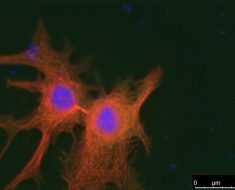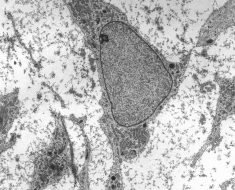
A study from researchers at the Massachusetts General Hospital (MGH) Cancer Center has demonstrated how the response to pancreatic cancer cells of normal tissue—called the stroma—within tumors can influence the ability of individual cancer cells to proliferate and metastasize. Their report, which details how differences in the relative amounts of tumor cells and stromal cells alter patterns of gene expression within individual tumor cells, is being published in Cell and may lead to improved therapies for this difficult-to-treat cancer.
“Our finding that pancreatic cancer cells can behave differently based on the types of cells that are around them may explain why some cells respond to chemotherapy and radiation and some do not,” says David Ting, MD, of the Tucker Gosnell Center for Gastrointestinal Malignancies in the MGH Cancer Center, co-senior author of the report. “We also identified a unique cell type that has the ability to replicate and to move at the same time, activates both the MAPK and STAT3 signaling pathways and is killed by combined use of MAPK and STAT3 inhibitors, suggesting a potential therapeutic strategy.”
The stroma of pancreatic tumors largely consists of connective tissue cells called cancer-associated fibroblasts (CAFs), along with immune cells and endothelial cells. While some studies have suggested that pancreatic CAFs contribute to the growth and spread of cancer, others have found that reducing CAFs led to more aggressive tumor behavior. These findings, along with the variability of stromal content within pancreatic tumors, suggested that interactions between CAFs and tumor cells are complex.
Recent studies by the MGH team found significant differences in gene expression between pancreatic cancer cells in the primary tumor and those circulating in the bloodstream, with some expressing signatures indicating proliferative features and others more metastatic potential. Subpopulations of cancers cells at the interface between tumor and stroma also expressed these differing genetic signatures, suggesting that they might be influenced by CAFs in the stroma.
The team’s current experiments revealed that:
- Culturing pancreatic tumor cells (PDACs) with CAFs led to changes in gene expression within cancer cells based on the relative proportions of the two types of cells within the culture. These differences allowed PDACs to be grouped into classes expressing either proliferative or metastatic/invasive signatures, and a subpopulation of “double-positive” cells simultaneously expressing both signatures was primarily seen in cultures with the highest proportion of CAFs.
- Tumors with different PDAC:CAF ratios implanted into immunodeficient mice led to changes in tumor growth and the distant spread of tumor cells, implying that stromal differences modulate the gene signatures and the proliferative and metastatic capabilities of pancreatic cancer cells.
- CAFs activate the MAPK and STAT3 signaling pathways in double-positive pancreatic cancer cells, and inhibitors of those pathways were more effective in cultures with high proportions of CAFs, with the greatest effects being produced by combining inhibitors of both pathways.
- Secretion of TGF-β by CAFs was found to drive the generation of double-positive PDACs, which provides a rationale for therapeutic agents that target TGF-β.
- Discrete tumor “glands,” comprised of clusters of PDACs, were more useful in predicting treatment outcomes than were individual cells, with glands consisting primarily of double-positive and metastatic/invasive cells associated with treatment resistance and poor patient survival. The prevalence of specific types of PDACs within tumor glands was influenced by the proportions of stromal to tumor cells within glands.
Source: Read Full Article





